Renata Marinković1, Suzana Tomaš2
1Faculty of Humanities and Social Sciences, University of Zagreb, Zagreb,10 000, Croatia
2Faculty of Philosophy, University of Split, Split, 21 000, Croatia
Correspondence to: Renata Marinković, Faculty of Humanities and Social Sciences, University of Zagreb, Zagreb,10 000, Croatia.
| Email: |  |
Copyright © 2012 Scientific & Academic Publishing. All Rights Reserved.
Abstract
The greatest contribution of the introduction of e-learning into education is the stimulation of active learning. E-learning with the appropriate programme support can specific phases of the educational process contributes to the individualization of education and stimulates the pupils’ activity. The attention of this paper is focused on the formation of educational content in the e-learning systems. Entering the activities of the subject they have enrolled, the third-grade elementary school pupils analyzed the educational materials, solved tasks and used educational tools for mutual cooperation and communication in the Moodle and CoLaB Tutor systems. By quality application of the mentioned systems in education results were achieved that pointed to the interest and excellent dispositions of this age group for specific forms of learning.
Keywords:
CoLaB Tutor, E-learning, Moodle, Instructional Design
Cite this paper: Renata Marinković, Suzana Tomaš, Instructional Design in E-learning for Primary Education, Education, Vol. 3 No. 3, 2013, pp. 185-195. doi: 10.5923/j.edu.20130303.07.
1. Introduction
World trends of electronic or e-learning have dominated educational processes and systems for a long while. However, the Croatian educational space and the quality within its frame is rather questionable due to lack of understanding, financial circumstances and general conditions that is dominant. Using e-learning a lot of the educational content approaches the pupils; it visually intrigues them and makes it possible for them that by using the computer they have the whole world at their grasp. The presupposition is definitely the acquisition of technical foreknowledge and creation of prerequisites, then motivation, organization and need for the acquisition if new knowledge in a different manner. The issue of marketing fluctuation, competition and information - communication competence assured via e-learning is going to be based on more quality implementation, managing and the results of educational processes.
2. Quality Management of Informatic Education Contests
The issue of quality generally is a delicate issue of criteria, valuation systems, structure of teaching material, structure of pupils (attendees, students), comprehension of the system by the educational authorities, strategy of the development of the society as a whole, all through to all its segments, and the like. In the continuing text we are going to dwell on the didactic-methodological elements of formation of educational content in specific informatics systems. For such a quality work certain conditions are posed of general educational criticality and measurability, criteria determinants, (fore) knowledge and capability of teachers and pupils necessary for the achievement of objective, quality results during testing. In the course of the implementation of the educational process, in addition to the application of relevant methods, contents, procedures and means, there is also the issue of comparability of the initial and final knowledge, i.e. results that we have expected. Have we achieved what we have expected? Have we offered what we have wanted? Were the possibilities of the implementation of what was conceived objective and expected? All these are issues that accompany us, and the responses come out of testing, motivation and functional (pedagogic, psychological) application of anticipated contents. As teachers evaluate their pupils using specific methods (e.g. by tests), so do pupils evaluate by their assessments the approach, competence and capabilities of their teachers. Are they always right? Presumably not. This certainly results from socially inadequate infiltration in the educational system and its implementation cycle via accessibility of content, literature, technical circumstances, staff potential, (in) organizability …In order to achieve the desirable quality of education via e-learning it is necessary to secure an intensive exchange of opinions, knowledge and experience, but also emotions if it relates to the younger school age. This is where the factor of coaxing the younger population for new, experimental forms of work. By a higher level of interest of the participants in such type of work a time-optimal rationality is achieved (learn more in a shorter time), rationality of content (selection of topics through corresponding applicability in practice) and personal rationality (who, how and why can be educated in this way).The determination of e-learning or models of education that are implemented in this manner differ in several forms of e-learning: –classical, frontal teaching in the schoolroom; –education supported by ICT: technology contributes to the enhancement of classical teaching (supported teaching and learning); –mixed, hybrid education – combination of classical teaching in the schoolroom and teaching supported by technology (hybrid, mixed mode, blended learning); teaching supported by ICT or on-line teaching that is entirely organized as distance education (fully on-line)[9].Each model of e-learning is specific because its design depends on several factors:–assessment of knowledge of pupils (attendees, students) – initial testing is implemented, and the process of harmonization of the module, contents and pupils' needs depends on the testing results; thus saving time of 30-50% is achieved (rationalization);–presentation of the material and contents that presupposes three steps: ○ introducing pupils to the aims (stronger motivation); ○ presentation of information, contents (audio-visually); ○ practising of acquired skills (repetition until pupils are not directed to the correct solution which applies to more complex programmes) investigation indicate that this type of learning results in 30% greater preciseness (correctness) in the performance of tasks but also with 40% greater speed of performing tasks which contributes to saving time;–assessment of knowledge–final testing is implemented, and the assessment tests are conceived in such a way that they simulate concrete tasks, so that the results could be seen but also the adequacy of the used methodology could be assessed.In order to check some of our theoretical preconceptions we tackled an experimental treatment and examination from the first to the fourth class pupils and determined their affinities and working capabilities applied to prepared, formatted educational materials in the Moodle and CoLaB Tutor systems.
3. Instructional design in the Systems Moodle and CoLab Tutor
The formation of educational content envelops a range of activities and is based on the linking of the theories of learning with the formation of software, in order to achieve the aim of learning[8]. The achievement of the aim in the process of learning offers guidelines on the basis of which the teaching process is formed in the system of shaping education. One of the applications of this system is the model of instructional design: Analysis, Design, Develop, Implement, Evaluate (ADDIE)[2]. The model ADDIE is the “tool” that preceded other models for the instructional design[7]. With this model the knowledge of the taught person is precisely ascertained, the environment of learning is analysed, the goals and tasks are defined and the basis for the transfer of new knowledge is created. This formatted and applied educational contents in the system of e-learning secure the necessary technology of interactive and adaptable environments for learning.The educational contents from the educational subjects Informatics and Nature and Society in the systems of e-learning Moodle and CoLaB Tutor in this work are formatted according to the model ADDIE. The model ADDIE envelops five phases: analysis, designing, development, implementation and evaluation. The analysis of pupils, the environment where they were going to conduct their educational process, the defining of the goal and educational tasks is carried out in the first phase – analysis. The phase of designing contains the goals of learning, application of instruments, planning of the educational process and use of the e-learning system. As a result, the blueprint of the particular lesson occurs in this phase of designing. The phase of development is the development of designing the educational contents from the previous phase and the interaction of lessons in the e-learning system. The preparation for the realization of education in the systems of e-learning is conducted in the phase of implementation and at the very end the phase of evaluation is realized[5].This work encompasses two researches within which there are defined the assessment and valuation of the results of the effect size of learning in e-learning systems with primary school pupils.The first research was conducted in the school year 2010/2011. The goal of this research was to define the difference of the learning effect size between the e-learning systems of Moodle and CoLaB Tutor. The third class primary school pupils were divided into two groups that in the mentioned systems learned the educational contents about the marine mammals.The goal of the second research (2011/2012) was the defining of the difference of the assessment and valuation of learning efficacy between the traditional learning and the learning in the system Moodle. This research encompasses pupils from the first to fourth class of the primary schools of the city of Split (Croatia). The pupils learned educational contents of the educational subject Informatics traditionally (education by lecturer) and in the system Moodle. The classes were randomly divided into controlling and experimental groups.Besides, this paper is also presenting results obtained after the pupils solved the objective-type tasks that pointed to the interest of this age group for this form of instructions about the learning progress.
3.1. Instructional Design in the System Moodle
Modular Object-Oriented Dynamic LearningEnvironment (Moodle) is a system for the management of the learning and teaching process. It offers to the teachers computer support for the organization, formation and implementation of educational contents[10]. Educational contents about marine animals in the subject Nature and Society and teaching content subject Informatics have been formed in six phases characteristic of the system Moodle.In the first phase there follows the log-on into the system with the username and password.The second phase encompasses the addition of the educational subject Nature and Society and Informatics from the first to fourth primary school class. This phase encompasses general postulates that refer to control, progress and possibility of formatting lessons in the educational subjects.In the third phase lessons are formatted as branch tables and as questions by which the formatter of the educational contents (teacher) defines the learning process.The content envelops the text, picture and animation (Figure 1). The types of questions are based on the models of possible answers: multiple choice, the principle of right wrong, short answers, connection, numerical answer and essay. | Figure 1. Page with a question in the lesson |
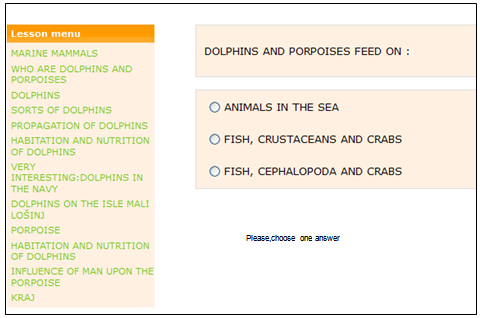 | Figure 2. Formatted page in the lesson Dolphins and Porpoises |
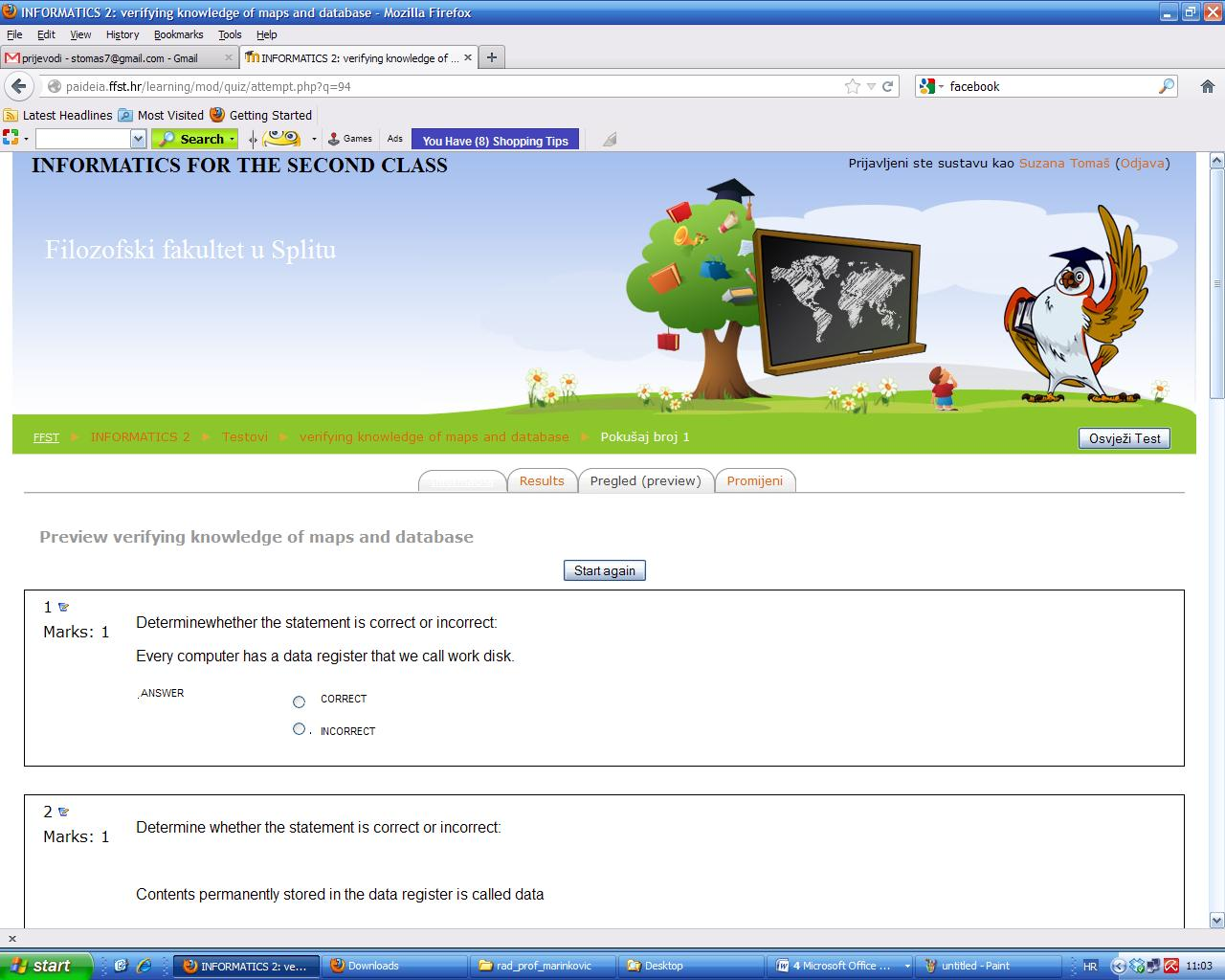 | Figure 3. Knowledge test – Informatics for the second class |
The educational theme in the first research is Dolphins and Porpoises. The second research encompasses the educational themes of the educational subject Informatics that is realized as an extracurricular educational subject from the first to fourth class of the primary school activity. The educational themes in the research of the 2011/2012 school year are presented in the Table 1.Table 1. Educational themes in the research carried out in 2011/2012 school year
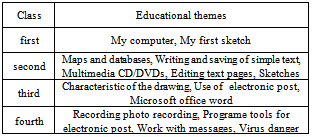 |
| |
|
Each page has the possibility of branching, transition to pages with questions (Figure 2) and instructions about the learning progress. Questions in the lessons can be scored and the progress in the lesson affects the total mark.In the fourth phase the text is drawn up where the settings are established by which the teacher determines the time, opening and closing of the test, the number of questions, number of attempts of solving the test, the mark and feedback.The design of the questions in the test followed in the fifth phase. The questions are not dependent on the test and they are grouped into categories linked to the educational topic, and out of these categories questions are selected for an individual test.The types of questions where answers are expected are: true/false, multiple choice, pairing, short answers, essay, numerical question with calculation, linking short answers and embedded replies.We completed the formation of the educational content with the sixth phase, the setting of the theme for the chat. After signing in the system Moodle the pupils from the first to the fourth primary school classes assessed all the system's modules and the learning process followed. Besides, immediately after the learning process the pupils in the chat room set out their observations about the lesson and the passed educational period.
3.2. Instructional Design in the System CoLaB Tutor
Controlled Language based Tutor (CoLaB Tutor)[13] is the intelligent tutorial system or system for tutoring established on the processing of ontology based controlled language. The realization of the functionality of CoLaB Tutor in the sequence of events is dividing in three phases. The subsystems CoLaB Tutor are in charge of their realization. In the first phase, the expert describes the area of ontological knowledge that consists of creating concepts and linking into relations supported by the Protége´ system[6].Based on the described knowledge area in the second phase the CoLaB Tutor system forms educational contents and the pupils’ model. The formation of the educational contents is made possible through the support of the Controlled Language Service (CoLaS)[13] subsystem and the subsystem Croatian Morphological Lexicon (Hrvatski morfološki leksikon (HML))[12].The CoLaS offers services of recognizing sets of word forms, i.e. phrases. The HML subsystem serves to generate and recognize morphological word forms.Communicating in the controlled language in the third phase, the pupils are learning, tutoring and testing. In the course of learning and tutoring, the controlled language are presenting by statements and in testing by interrogative sentences. | Figure 4. Elements of educational content assigned for learning |
 | Figure 5. Elements of tutoring dialogue |
The knowledge area about the ontology “Marine mammals” includes 25 concepts, 7 relations and 9 pictures (Figure 4).The process of learning and testing of knowledge is monitored by the computer supported by the tutoring dialogue (Figure 5).Before beginning the learning process, the pupils entered the usernames for the system log-on followed by the welcome message and the menu. After the system log-on the pupils are presented with controlled language sentences that have been generated on the basis of concepts in the elements of the educational content
4. Analyses of Results of Objective Type 1 Tasks (OTT1) and Objective Type 2 Tasks (OTT2) for Researches in the 2010/2011 School Years
The aforementioned systems after the formation of educational contents were applied in the elementary school Spinut in Split (Croatia) in two third grade classes, with 25 pupils in each of them.Before teaching the educational content in the systems Moodle and CoLaB Tutor, the pupils solved objective type tests. The objective type tests were drawn up in two parallel forms. OTT1 for the identification of the initial state and OTT2 for the identification of the final state related to the topics dolphins and porpoisesBy these instruments we determined the level of the pupils' knowledge before and after the tutoring.In this way we got statistical indicators: the arithmetic mean (AM), standard deviation (SD) and t-values and determined how much the pupils progressed in their learning.In the continuation final results are presented, obtained by comparison of OTT1 and OTT2 for both systems.OTT1 is statistically significant and that in favour of OTT2 (Table 2). The curve OTT2 was shifted to the right which presents the results of higher values in relation to the results in OTT1 (Graph 1). As the consequence of these results it can be concluded that the pupils progressed after tutoring in the system Moodle.The absolute value of the t-value (5.17) at the level of significance 0.05 is bigger than the limiting value (2.02), which implies that the difference in the results OTT2 and OTT1 is statistically significant and that in favour OTT2 (Table 3).The curve of the OTT2 results was shifted to the right which presents the results of higher values in relation to the OTT1 results (Graph 2).Table 2. Difference between OTT2 and OTT1 – Moodle
 |
| |
|
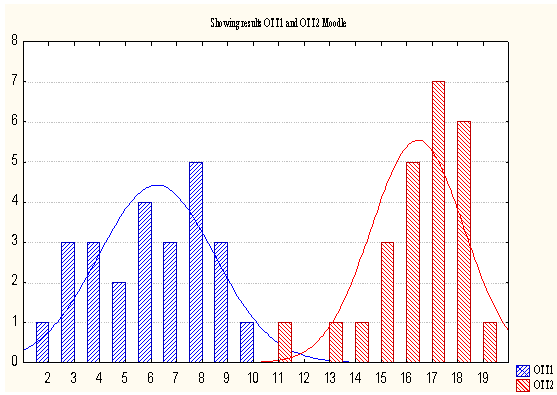 | Graph 1. Presentation of results of OTT2 and OTT1 – Moodle |
Table 3. Difference between OTT2 and OTT1 – CoLaB Tutor
 |
| |
|
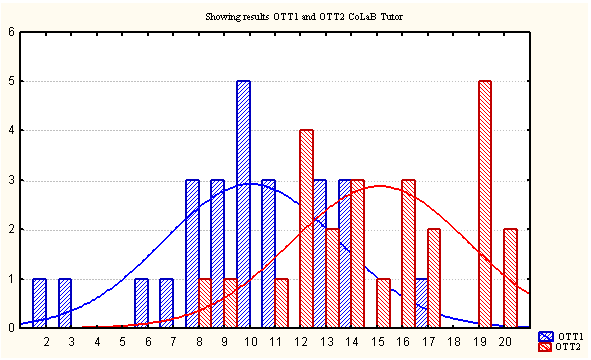 | Graph 2. Presentation of results of OTT2 and OTT1 – CoLaB Tutor |
The absolute value of the t-value at the level of significance 0.05 and degree of freedom (df) is 48 bigger from the limiting value (2.02) and amounts to 17.61, which points to the fact that the difference in the results OTT2 and Observing the results of the pupils' OTTs we can conclude that pupils tutored in the CoLaB Tutor system were better in the solving of OTT1 though they showed significantly worse results after solving OTT2. The reason of this outcome is that the educational content in the system Moodle were formatted by pages where the content was visible as a whole. The pupils were accustomed to learn in this way as opposed to the educational content presented in the CoLaB Tutor system that was formatted in concepts. The pupils had to understand these educational contents and had to learn them by observing concepts which posed problems for them. We noticed that the pupils in their spare time used to log-on in the system, exchanging their opinions about the educational content.
5. Analysis of Results of Objective Type 1 Tasks (OTT1) and Objective Type 2 Tasks (OTT2) for Researches in the 2011/2012 School Years
Educational contents in Informatics were formatted in the system Moodle and applied in four primary schools of the city of Split (Croatia). With this research there were 154 pupils encompassed from the first to fourth class of the primary school (Table 4).Table 4. Examinees in the research
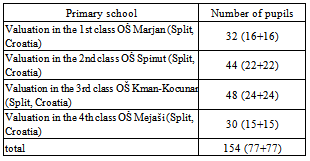 |
| |
|
This research pertains to various experiments considering the age group of the pupils and the educational contents. Each experiment had two groups: controlling and experimental. The pupils in the controlling group learned the educational contents in the traditional way, while the pupils of the experimental group learned the educational contents in the system Moodle. Experimental and controlling groups were chosen by random selection. Prior to teaching the educational contents in the system Moodle or by the traditional manner of learning, the pupils solved tasks of the objective type. The tasks of objective type were combined in two parallel forms: OTT1 for the defining of the initial state and OTT2 for the defining of the final state. Applying initial examination we tested the current level of the pupils’ knowledge, while with the final examination we tested whether the pupils, learning by the application of the e-learning system and the traditional manner adopted educational contents. The objective type tasks were combined in harmony with the educational plan and programme of the educational subject Informatics from the first to fourth primary school class. Furthermore, pupils in the experimental groups filled in the questionnaire that we used to query the pupils’ satisfaction regarding learning via the system Moodle.The obtained results of the objective type tasks OTT1 and OTT2 were compared mutually via interconnection and calculated effect size. The effect size quantifies the volume of the difference between the controlling and experimental groups. Considering the fact that there are several manners of calculating the effect size of difference of results, we opted for the Glass effect size[4]. Glass suggested the inclusion of standardised effect size which he named Glass’s delta (Δ) and it is calculated by dividing the difference between the arithmetic mean of the experimental and controlling groups with the standard deviation of the controlling group. The marker of the effect size is the Greek letter sigma. Cohen[3] supposes the values effect size ca 0,2 sigma are small, and quotes the example of the difference between the girls aged 15 to 16 that correspond to this effect size. The effect size of 0,5 sigma is considered moderate and big enough to be seen by the “naked eye”, so Cohen quotes that this effect size corresponds to the height of girls aged from 14 to 18. The effect size of 0,8 sigma is considered big, and the quoted example is the difference between the height of girls aged from 13 and 18.Subsequently, each the quoted example is separately described in the sequence.
5.1. Analysis of the Experiments in the First Classes
The experimental and controlling groups encompassed 16 pupils per class of the first classes of the Primary School Marjan, (Split, Croatia). The pupils of the controlling and experimental groups taught the educational subjects My computer and My first sketch. Both themes in the controlling group the pupils learned in the traditional manner, in the experimental group in the system Moodle. The deficiency of computers in the computer classroom made it impossible for pupils to learn individually but had to learn in pairs.Table 5. Difference between the controlling and experimental groups in OTT1 and OTT2
 |
| |
|
The absolute value of t-ratio in the objective type 2 tasks on the significance level 0.05 and the degree of freedom 30 is smaller than the bordering (2,04) and amounts to 0,31, which points to the fact that the difference in the results of OTT2 is statistically not significant. Based on the results, the difference in the results of OTT2 and OTT1 of both groups the effect size was calculated and amounts to 0,63 of standard deviation.Considering the plus sign, the experimental group is statistically more successful than the controlling group.According to Cohen[3] this effect size is moderate and big enough that the difference in the results can be seen “with the naked eye”.
5.2. Analysis of the Experiments in the Second Classes
The examinees in this experiment were second class pupils of the Primary School Spinut (Split, Croatia). The experimental and controlling group numbered 22 pupils per class.The pupils of the controlling group traditionally learned educational contents Maps and databases, Writing and saving of simple texts, Multimedia CD/DVDs, Editing text pages, Sketches (three lessons). The pupils of the experimental groups had the same educational contents in the system Moodle.The initial examinations of knowledge, the results of the OTT1 pointed to the equivalence of both groups so that the research was continued (Table 6).Table 6. Difference between the controlling and experimental groups in OTT1 and OTT2
 |
| |
|
Results the final examination of the learned show that the efficacy of learning on a selected text amounts to -0,12 sigma in favour of the controlling group. Considering the achieved results this effect size is small and the controlling group is not significantly better than the experimental one.
5.3. Analysis of the Experiments in the Third Classes
The pupils of the third classes in this experiment are pupils of the Primary School Kman-Kocunar (Split, Croatia) and there were 48 pupils encompassed by the experiment. By random selection one class was chosen for the controlling and the other for the experimental group. The educational themes for both groups were: Characteristics of drawing Use of the electronic post and Microsoft office word. The pupils of the experimental group learned the educational contents individually in the system Moodle.The absolute value of the t-ratio in OTT1 is statistically not significant and this defines the fact that the groups are equivalent. While the t-ratio on the level of significance of 0, 05 and the degree of freedom 46 amounts to 4,07 and is statistically significant because it is higher than 2, 03 (Table 7).The effect size of OTT2 between the controlling and experimental group of third classes is 1,49 sigma in favour of the experimental group. This effect size volume of according to Cohen[3], is considered to be big.Table 7. Difference between the controlling and experimental groups in OTT1 and OTT2
 |
| |
|
5.4. Analysis of the Experiments in the Fourth Classes
The number of pupils of the Primary School Mejaši (Split, Croatia) in both groups amounts to 30, which mean that the controlling group counts 15 pupils and the experimental group also counts 15 pupils. The educational themes Recording photo recording, Programme tools for electronic post, Work with messages, Virus danger – the pupils of the experimental group learn in the system Moodle after they have been divided into pairs.After the analysis of results of the initial (OTT1) and final (OTT2) examination it was defined that the groups were equivalent. The analysis of results of the final examining defined that the obtained results were equalled which can be noted in the mentioned table (Table 8).From the above mentioned follows that the controlling group is statistically insignificantly better that the experimental group and the effect size amounts to -0, 28 sigma.On the basis of arithmetic mean and standard deviation of the results of the difference between OTT2 and OTT1 we defined the effect size (sigma) for the mentioned researches carried out in the school year 2011/2012, which is presented in the Table 9.The pupils of the first, second and fourth classes of the experimental groups learned in the system Moodle in pairs, and this was reflected on the results that the pupils achieved by solving tasks of objective type. The third year class pupils of the experimental group achieved the best assessment and valuation of the results of the effect size. The reason for this high result is the fact that these pupils had the best conditions of learning in the system Moodle. They learned individually, and during instruction one-to-one, with real living teacher in his research Bloom achieved 2,00 sigma[1]. In this way, in their relation to pupils who learned in pairs, they had more time for individual learning and mastering educational contents in the system Moodle. Besides, also accepting Cohen's interpretation of the effect size[3], we can conclude that it is great only in the third class of the experimental group. That means that the accomplishment of the pattern in this experiment is great.Table 8. Difference between the controlling and experimental groups in OTT1 and OTT2
 |
| |
|
Table 9. Effect size 2011/2012
 |
| |
|
Table 10. Comparative analysis of both researches
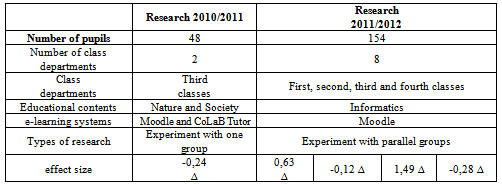 |
| |
|
The researches that we implemented in the two school years 2010/2011 and 2011/2012 with pupils of primary education were directed on the example of two systems e-learning: Moodle and CoLaB Tutor. We expected that the pupils were going to accept the e-learning systems. Whatever is new and based on computers, for children at the age of pupils from our example is accepted with great joy. We have not foreseen with assurance what achievements the pupils were going to complete in the implemented experiments. The effect size that our pupils of experimental groups in all class departments is not very high (Table 9), but the pupils' satisfaction after learning in the e-learning systems encouraged us and proved our expectations.In the same way the special efficacy analysis of learning by means of two systems of e-learning, Moodle and CoLaB Tutor, was the same parallel research with the application in one part with traditional learning and in the other one with the e-learning system.Experimental results were presented in two e-learning systems, but for illustration and not necessarily for comparing; we researched the mutual relation of experimental experience of pupils that worked on the e-learning system with pupils who adopted the same material in the classical, traditional manner (Table 10).Applying the presented analysis, what were defined were differences, factors of efficacy and results. The general reasons of efficacy are more difficult to carry out than emphasize specific indicators that stimulate children for new, more dynamic, faster, more efficient thinking and learning. It is sometimes not necessary to compare nor is it desirable because every process is based on individuals who, each in his/her manner propound their own individualism. This is where the specificities in inputs, but also specificities in outputs occur. This is what the personal differences, prior knowledge, experience, intellectual capacities, personal interests and motives, familiar ambience and orientation, material and technical circumstances and the like all come from.Except for the already above mentioned tasks of objective type that were used for the initial and final examining of the pupils' knowledge, there was also a questionnaire prepared for checking the pupils' satisfaction after learning in the system Moodle.
6. Analysis of the Pupils' Satisfaction Questionnaire of Learning in the System Moodle
The questionnaire was filled by 77 pupils of the experimental group subsequent to learning in the system Moodle; there were 31 boy and 46 girls (Figure 6).From the total of 77 pupils 62 of them experienced the system Moodle as interesting, instructive and amusing for learning, communication and cooperation. Furthermore, 43 pupils stated that they prefer learning in the system Moodle because they memorize the educational contents and have a “guide” that gives them an overview of the whole of the educational content.Half of the pupils (49%) would prefer to exchange the usual manner of learning with the system Moodle in all educational subjects, 44% would like to learn only part of the subjects by the system Moodle, and only 7% of pupils would not use the system Moodle at all (Figure 7).Reasons stated in favour of the system Moodle are the fact that they experience such learning easier and more amusing, the fact that they learn via computers and the Internet and the fact there is no nerve-racking while they solve a test that they can solve several times, the fact that they learn at home and need to write. These answers of the pupils show their motivation and satisfaction with the application of the system Moodle. | Figure 6. Pupils' questionnaire pattern |
 | Figure 7. Presentation showing how many pupils wants to learn in the system Moodle |
The system Moodle is also developed on the principles of “guide free play“[11]. This possibility allows the pupils to master educational contents faster by skipping certain parts of these contents. In this way individual learning is made possible; in favour of this claim there is the comment of a third class pupil expressed at the end of the lesson:”I like it because I can learn when I want and I can continue from where I stopped; I can start learning from the start; I like it because I do not need to wait for the others to complete the task”.The application of the computer in education is inevitable; the directing of pupils from the earliest age to start independent learning is going to open to them more possibilities in the future professional orientation.
7. Conclusions
In learning via e-learning systems there occurs the problem the disposition of the pupils for the acquisition of educational content which demands the pupils' greater motivation, discipline and personal organization in order for the tasks to be qualitatively fulfilled. Though pupils encountered difficulties by learning in the e-learning systems, they expressed interest for this type of tutoring, logging-on into the systems in their spare time because of the originality and independence in their engagement.The classes that were held pointed to the possibility of the application of both systems in the elementary school as well as to the possibility of application of these systems in various circumstances.Such possibilities of formatting educational contents open a space for creative work and personal elevation to the teacher/professor.We can conclude that the computer with an appropriate programme support contributes to the process of acquisition of knowledge and skills and develops the pupils' abilities. In our case, the appropriate programme support is exactly the support of the Intelligent Tutoring Systems and the Learning Management System.Working with the computer has to be directed at completeness, individualisation, opening and performance, and this will solve a range of problems and enable more efficient achievement of goals of educational activities and the educational process.
References
| [1] | Bloom, B. S., The Two-Sigma Problem: The Search for Methods of Group Instruction as Effective as One-to-One Tutoring. Educational researcher, 13, pp.4-16, 1984. |
| [2] | Branson, R. K., Rayner, G. T., Cox, J. L., Furman, J.P., King, F. J., Hannum, W. H., „Interservice procedures for instructional systems development“ in TRADOC Pam 350-30 NAVEDTRA 106A., Ft. Monroe, VA: U.S., 1975, vol.5 |
| [3] | Cohen, J. (1969), Statistical Power Analysis for the Behavioral Sciences. New York: Academic Press:[Online]. Available:http://www.pigncispi.com/articles/education/brief%20history.htm |
| [4] | Glass, G.V., McGaw, B., Smith, M.L., 1981, Meta-Analysis in Social Research. Sage Publications, London. |
| [5] | Instructional design, using the ADDIE Model.[Online]. Available: http://www.raleighway.com/addie/ |
| [6] | Knublauch, H., Fergerson, R.W., Noy, N.F., Musen, M.A., “The Protégé OWL Plugin: An Open Development Environment for Semantic Web Applications”, in Third International Semantic Web Conference ISWC 2004; Hiroshima, Japan. |
| [7] | Kovalchick, A., Dawson, K. (2003), Ed's, Educational Technology: An Encyclopedia. Copyright by ABC-Clio, Santa Barbara.[Online]. Available:http://www.indiana.edu/~molpage/Instruc_Technol_Encyclo.pdf |
| [8] | Leigh, D. (2003), A Brief History of Instructional Design:[Online]. Available:http://www.pignc-ispi.com/articles/education/brief%20history.htm. |
| [9] | Marinković, R., 2004, Inteligentni sustavi za poučavanje (Intelligent Tutoring Systems), Hrvatska zajednica tehničke kulture, Zagreb, Croatia,. |
| [10] | Modular Objecat-Oriented Dynamic Learning Enviroment (Moodle),[Online]. Available: http://Moodle.org |
| [11] | Sugarman, R.: A second chance for computer-aided instruction. IEEE Spectrum, 15(8),1978 |
| [12] | Tadić, M., Fulgosi, S., “Building the Croatian Morphological Lexicon” in Proceedings of the EACL 2003 Workshop on Morphological Processing of Slavic Languages, Budapest, Hungary, 2003. |
| [13] | Žitko, B., 2010, Model inteligentnog tutorskog sustava zasnovan na obradi kontroliranog jezika nad ontologijom[Model of Intelligent Tutoring Systems based on the elaboration of controlled language upon ontology], Faculty of Electrical Engineering and Computing, University of Zagreb (Croatia), doctoral dissertation, Zagreb. |










 Abstract
Abstract Reference
Reference Full-Text PDF
Full-Text PDF Full-text HTML
Full-text HTML








